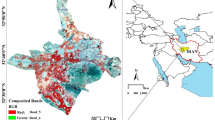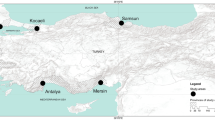Abstract
Socioeconomic forces are not only among the main drivers of landscape dynamics; they are also influenced by landscape patterns. Landscape structure and functions are closely related to natural and social factors. The objective of this study was to investigate the relationships among some human-related factors and landscape ecological metrics as landscape pattern indicators and to identify suitable metrics for modeling these relationships. To this goal, landscape ecological metrics were calculated for each of the 32 counties of Mazandaran and Guilan provinces located in the southern basin of the Caspian Sea using land use/cover maps in class level. Stream network metrics were calculated using a digital elevation model, road density metrics were calculated using map of main roads separately, and significant metrics were selected according to results of correlation tests and factor analysis. The correlations between these metrics and socioeconomic factors were tested, and their relationships were modeled with multiple linear regressions. Significant relationships were found among socioeconomic factors and landscape ecological metrics, and land use/cover data are applicable for modeling socioeconomic factors, especially demographic and employment structure factors. Among the landscape metrics applied in this study, road density, mean patch size, mean nearest neighbor distance, and percentage of a land use/cover class in landscape were important metrics for predicting socioeconomic factors. Our findings indicated that road density metric and percentages of urban class are useful for predicting urban socioeconomic factors and percentage of agriculture and forest classes in the landscape are suitable metrics for predicting rural socioeconomic factors.


Similar content being viewed by others
Notes
Copyright©1999–2010 ESRI, Inc.
© 2010 Minitab, Inc.
Copyright 1993–2007 Polar Engineering and Consulting
References
Abdullah, S. A., & Nakagoshi, N. (2006). Changes in landscape spatial pattern in the highly developing state of Selangor, peninsular Malaysia. Landscape and Urban Planning, 77, 263–275.
Afshin, Y. (1994). Rivers of Iran. JAMAB engineering cooperation: Ministry of Energy (In Persian).
Ahmadi, H., Rouh Bakhsh Sigaroudi, H., FallahGhavibazouLayalestani, S. M., GolzadNanehKaran, N., Hasan Beigi, Y., Azarhoush Fatideh, A., & Darvishi, S. (2012). Guilan Province (3rd ed.). Iran: Textbook publishing companies (In Persian).
Aljoufie, M., Zuidgeest, M., Brussel, M., & Van Maarseveen, M. (2013). Spatio-temporal analysis of urban growth and transportation in Jeddah city, Saudi Arabia. Cities, 31, 57–68.
Amiri, B. J., & Nakane, K. (2008). Modeling the linkage between river water quality and landscape metrics in the Chugoku district of Japan. Water Resource Management, 23, 931–956.
Blanchet, F. G., Legendre, P., & Borcard, D. (2008). Forward selection of explanatory variables. Journal of Ecology, 89(9), 2623–2632.
Cradille, J. A., & Turner, M. G. (2002). Understanding landscape metrics I. In S. E. Gergel & M. G. Turner (Eds.), Learning landscape ecology (pp. 85–101). New York: Springer-Verlag.
Cumming, S., & Vernier, P. (2002). Statistical models of landscape pattern metrics with applications to regional scale dynamic forest simulations. Landscape Ecology, 17, 433–444.
Digital elevation data (ASTER GDEM). A product of METI and NASA, http://gdex.cr.usgs.gov/gdex/.
Food and Agriculture Organization of the United Nations (FAO). (1998). Biodiversity for food and agriculture, an extract from “Human Nature: agricultural biodiversity and farm based food security”. http://www.fao.org/sd/epdirect/epre0040.htm. Accessed 10 July 2014.
Food and Agriculture Organization of the United Nations (FAO). (2012). State of the World’s Forests, http://www.fao.org/docrep/016/i3010e/i3010e00.htm. Accessed 10 July 2014.
Fields, G. (1999). Urbanization and the transition from agrarian to industrial society. Berkeley Planning, 13(1), 102–128.
Gergel, S. E., & Turner, M. G. (Eds.). (2002). Learning landscape ecology, a practical guide to concepts and techniques. New York: Springer-Verlag.
Glover, D. R., & Simon, J. L. (1975). The effect of population density on infrastructure: the case of road building. Economic Development and Cultural Change, 23(3), 453–468.
Haan, A.D. (2000). Urban livelihoods and labor markets. A 2020 vision for food, agriculture and the environment. International Food Policy Research Institute (IFPRI), Focus 3, Brief 4 of 10, http://www.ifpri.org/sites/default/files/publications/focus03_04.pdf. Accessed 12 July 2014.
Herzog, F., Lausch, A., Muller, E., Thulke, H.-H., Steinhardt, U., & Lehmann, S. (2001). Landscape metrics for assessment of landscape destruction and rehabilitation. Environmental Management, 27(1), 91–107.
Hietel, E., Waldhardt, R., & Otte, A. (2005). Linking socioeconomic factors, environment and land cover in the German Highlands, 1945–1999. Journal of Environmental Management, 75, 133–143.
Hietel, E., Waldhardt, R., & Otte, A. (2007). Statistical modeling of land cover changes based on key socioeconomic indicators. Ecological Economics, 62, 496–507.
Hong, S.-K., Wu, J., Kim, J.-E., & Nakagoshi, N. (2011). Landscape ecology in Asian cultures. Tokyo Dordrecht Heidelberg London New York: Springer.
Hu, Z., & Lo, C. P. (2007). Modeling urban growth in Atlanta using logistic regression. Computers, Environment and Urban Systems, 31, 667–688.
Kim, J.-E., & Hong, S.-K. (2011). Pattern and process in MAEUL, a traditional Korean rural landscape. Journal of Ecology and Field Biology, 34(2), 237–249.
Lausch, A., & Herzog, F. (2002). Applicability of landscape metrics for the monitoring of landscape change: issues of scale, resolution and interpretability. Ecological Indicators, 2, 3–15.
Leitao, A. B., & Ahern, J. (2002). Applying landscape ecological concepts and metrics in sustainable landscape planning. Landscape and Urban Planning, 59, 65–93.
Li, X., He, H. S., Bu, R., Wen, Q., Chang, Y., Hu, Y., & Li, Y. (2005). The adequacy of different landscape metrics for various landscape patterns. Pattern Recognition, 38, 2626–2638.
Luo, J., & Wei, Y. H. D. (2009). Modeling spatial variations of urban growth patterns in Chinese cities: the case of Nanjing. Landscape and Urban Planning, 91, 51–64.
Martinez, J. M. A., Suarez-Seoane, S., & Calabuig, E. D. L. (2011). Modelling the risk of land cover change from environmental and socioeconomic drivers in heterogeneous and changing landscapes: the role of uncertainty. Landscape and Urban Planning, 101, 108–119.
McGarigal, K., & Marks, B. J. (1994). FRAGSTATS: spatial pattern analysis program for quantifying landscape structure. Available at: www.umass.edu.
Mesgari, A., Pazoki, A., Rouhi, N., Yasari, N., Vaseghi, L., Ahmadi, J. (2007). Statistical yearbook of Mazandaran Province. Management and planning organization of Mazandaran Province Press (In Persian).
Minitab support. Available at: http://support.minitab.com/en-us/minitab/17/topic-library/modeling-statistics/regression-and-correlation/goodness-of-fit-statistics/what-is-prediction-sum-of-squares/
Narumalani, S., Mishra, D. R., & Rothwell, R. G. (2004). Change detection and landscape for inferring anthropogenic processes in the greater EFMO area. Remote Sensing of Environment, 91, 478–489.
Rempel, R. S., Kaukinen, D., & Carr, A. P. (2012). Patch analyst and patch grid. Ontario: Ontario ministry of natural resources. Center for northern forest ecosystem research. Thunder Bay. available at http://cnfer.on.ca/SEP/patchanalyst/.
Southworth, J., Nagendra, H., & Tucker, C. (2002). Fragmentation of a landscape: incorporating landscape metrics into satellite analyses of land-cover change. Landscape Research, 27(3), 253–269.
Tarzaban, S., Hadian, S. A. A., Shohadayi, S. H., JanbazGhobadi, G., Pezeshki, M., KazemiKavardi, M. M., Soleimanibashali, M., & Dabuyi, R. (2012). Mazandaran Province (3rd ed.). Iran: Textbook publishing companies (In Persian).
Tian, Y., Yue, T., Zhu, L., & Clinton, N. (2005). Modeling population density using land cover data. Ecological Modeling, 189, 72–88.
Uuemaa, E., Roosaare, J., & Mander, U. (2005). Scale dependence of landscape metrics and their indicatory value for nutrient and organic matter losses from catchments. Ecological Indicators, 5, 350–369.
Zonneveld, I. S. (1995). Land ecology: an introduction to landscape ecology as a base for land evaluation, land management and conservation. Amsterdam: SPB academic publishing.
Author information
Authors and Affiliations
Corresponding author
Appendix
Appendix
Table 4
Table 5
Rights and permissions
About this article
Cite this article
Ghafouri, B., Amiri, B.J., Shabani, A.A. et al. Examining Relationships Between Socioeconomic Factors and Landscape Metrics in the Southern Basin of the Caspian Sea. Environ Model Assess 21, 669–680 (2016). https://doi.org/10.1007/s10666-016-9503-9
Received:
Accepted:
Published:
Issue Date:
DOI: https://doi.org/10.1007/s10666-016-9503-9




